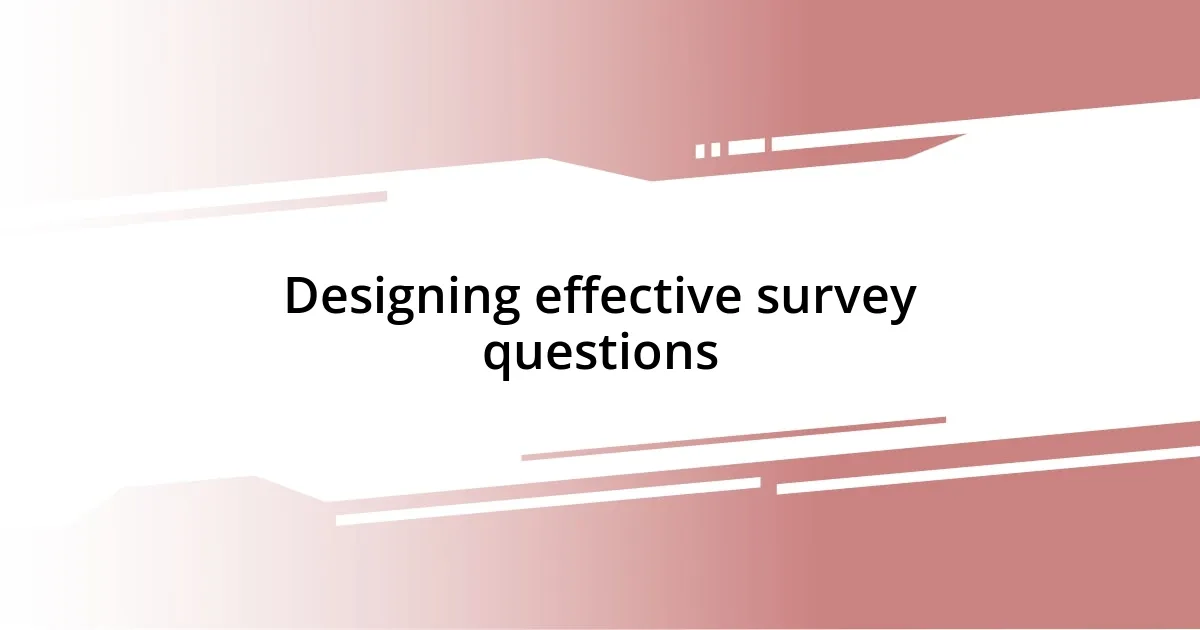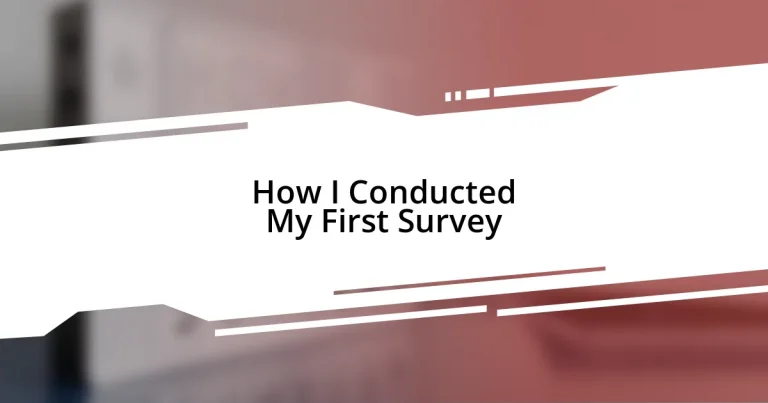Key takeaways:
- Craft clear and focused survey questions to capture genuine insights.
- Select a representative sample and define specific survey goals to guide data collection.
- Choose the right survey method tailored to your audience for optimal engagement and data quality.
- Visualize data effectively and collaborate on insights to enhance understanding and actionable recommendations.

Understanding survey fundamentals
Surveys are a powerful tool for gathering data and insights, but understanding their fundamentals is crucial. I remember diving into my first survey, feeling a mix of excitement and apprehension—would my questions genuinely capture the voices of my respondents? It’s vital to craft questions that are clear and focused, allowing the data to reflect true sentiments rather than confusion.
One of the key elements I learned is the importance of question types. For example, multiple-choice questions can be great for quantifying opinions, but open-ended questions truly allow respondents to express their thoughts in their own words. Have you ever considered how the way you frame a question can impact the responses? I’ve found that even subtle wording changes can lead to significantly different answers, which can be both enlightening and frustrating.
Another aspect I tackled was sample selection. Early on, I didn’t grasp how crucial it was to have a representative sample. It hit me hard when I realized that surveying just my friends would lead to a biased view. I aimed for a diverse group, and the richness of responses was astonishing—it made me rethink my initial perceptions and opened my eyes to different perspectives. This aspect of survey design has taught me that every voice counts in shaping a more holistic understanding of the topic at hand.

Defining your survey goals
Defining your survey goals is one of the crucial first steps that can shape the direction of your entire project. I recall sitting down with a notebook, feeling the weight of the responsibility to ask the right questions. It struck me how vital it is to be specific about what I wanted to achieve. Instead of going in with a vague idea, taking the time to outline clear objectives gave me a roadmap that guided my survey’s focus.
- Consider what information you truly need.
- Think about the decisions that will be influenced by the survey results.
- Set measurable goals, whether that’s understanding customer satisfaction or gauging interest in a new product.
- Reflect on how you’ll use the insights gathered—this can refine your questions significantly.
By framing my intentions this way, I felt more confident in crafting meaningful questions that aligned with my goals. This clarity not only keeps you on track but also enhances the respondents’ experience by providing them with relevant context.

Choosing the right survey method
Choosing the right survey method can significantly influence the quality of your data. I remember my initial struggle while deciding between online surveys and face-to-face interviews. Online surveys seemed convenient and cost-effective, allowing broader reach, but I worried they might not capture the nuances of respondents’ feelings compared to the personal touch of interviews. Ultimately, I found a blend of both methods worked best, achieving a balance between comprehensive data collection and insightful, richer responses.
Another consideration is the audience you’re targeting. I truly believe that understanding your demographic helps decide the survey method. For instance, if you’re surveying tech-savvy millennials, a digital format might be appropriate. In contrast, older adults may prefer a traditional paper survey. Tailoring your method to fit your audience not only boosts engagement but also ensures that you gather more reliable data. I learned this lesson the hard way; my first survey missed the mark because I didn’t consider the preferences of my respondents.
Finally, the survey’s purpose can dictate its method. If your goal is to gain quick feedback, a short online survey may suffice. However, if you’re diving deep into complex topics, in-person interviews or focus groups may yield better insights. I experienced this firsthand when a simple survey fell flat because it couldn’t capture the depth of opinions I needed. Choosing the right method is not just a logistical decision; it’s about ensuring you hear your respondents’ voices loud and clear.
| Survey Method | Advantages |
|---|---|
| Online Surveys | Cost-effective, larger reach, quick responses |
| Face-to-Face Interviews | Depth of insight, human connection, ability to clarify questions |

Designing effective survey questions
Designing effective survey questions is an art that can make or break your data collection. During my first survey experience, I learned that clarity is key—if a question isn’t straightforward, it can lead to confusion and unusable responses. I remember crafting a question about customer satisfaction that was way too complex, and afterward, I was left scratching my head at the results. Keeping questions simple and direct not only helps respondents understand what I’m asking, but it also leads to more accurate data.
It’s also vital to consider the type of questions you’re using. I found that mixing closed-ended questions, which provide clear options, with open-ended ones, where respondents can express their thoughts freely, creates a balanced approach. After receiving feedback that some of my closed-ended questions were too limiting, I began incorporating open-ended prompts. This shift allowed me to capture richer insights and, honestly, it made the responses feel more personal. How often do we really want just a number when we can have a story?
Additionally, I discovered the importance of avoiding leading questions that may sway responses. One of my first attempts included a poorly worded question that suggested a “correct” answer. The moment I realized how this could compromise my data integrity, I felt a wave of embarrassment. Design your questions with neutrality in mind; it’s all about fostering a space for honest, uninhibited feedback. In the end, steering clear from biased phrasing ensures that your survey captures genuine thoughts, enabling you to glean insights that truly reflect your audience’s views.

Distributing the survey effectively
When it came to distributing my survey, I quickly realized that choosing the right platform was crucial. I opted for an online survey tool because it aligned perfectly with my intended audience, but I also didn’t overlook the importance of social media promotion. I vividly remember posting an announcement on my personal social accounts and getting some reassurances from friends—I was so excited when they started sharing it, too! That organic outreach helped me reach diverse groups while giving me initial confidence in the project.
Timing can also play a big role in how effectively your survey gets distributed. I learned this lesson the hard way; my first attempt was during the holiday season when everyone was busy. The response rate was disheartening, and I found myself questioning if people were even seeing my survey. Shifting my distribution to a more mid-year timeframe really boosted participation, and it felt great to see more responses flow in as I tapped into a more engaged audience.
Finally, I can’t stress enough the importance of a personal touch. Sending out a personalized message along with the survey link made a world of difference. I recalled how I had originally sent a generic email, and the results reflected that lack of connection. Once I started reaching out individually, mentioning something specific about each person’s experience, it felt more authentic. People appreciate being acknowledged, don’t they? Building that rapport really encouraged genuine participation, leading to richer data that reflected real voices and experiences.

Analyzing survey results
Once I received my survey responses, the real challenge began: analyzing the data. I must admit, staring at spreadsheets full of numbers felt overwhelming initially. However, breaking down the results into manageable sections helped greatly. For example, I separated response categories to see patterns more clearly. Wasn’t it fascinating to realize that some questions yielded clear trends while others opened the door to unexpected insights? This process was like solving a puzzle; each piece added depth to my understanding.
I learned that visual tools made a significant difference. Initially, I crammed all my findings into dense paragraphs, which only made it harder to draw conclusions. But when I started using charts and graphs, everything clicked. I was astounded by how visual representations could highlight correlations I had missed before. Isn’t it amazing how a good visual can turn data into a story? I remember a bar graph comparing satisfaction levels; it told me far more than the numbers ever could.
Moreover, discussing my findings with a trusted colleague brought fresh perspectives. I had become so immersed in the data that I lost sight of the bigger picture. Conversations can shed light on nuances, like why a particular group rated their experiences differently—something I hadn’t considered. Have you ever found that talking through your thoughts helps clarify your understanding? For me, it turned analysis into a collaborative experience, enriching my learning and ensuring that my conclusions reflected more than just my solitary vision.

Drawing actionable insights from data
Drawing actionable insights from the data can be a truly enlightening experience. As I dove into the results, I was surprised at how some findings just jumped out at me. It was like uncovering a hidden treasure! For instance, one question revealed a much higher level of satisfaction among a specific demographic. This made me wonder—what were they doing differently? I felt an immediate spark of curiosity, pushing me to explore this further and tailor my future strategies accordingly.
The real magic happened when I started synthesizing the data into actionable recommendations. I’ll never forget the moment I realized that my survey had illuminated a gap in service that I hadn’t fully recognized before. In retrospect, this kind of insight can genuinely steer a project in a new direction. So, I asked myself: How can I improve those areas? Well, I crafted a targeted plan based on what the data suggested, and it was incredibly rewarding to put my findings to use.
I also found it essential to revisit my original objectives while drawing insights. It’s easy to get lost in the details and let intriguing data lead you down rabbit holes. Reflecting on what I hoped to achieve helped keep me focused. Have you ever experienced that moment when everything just clicks into place? For me, it was when I aligned my observations with my goals, allowing the data to shape my next steps instead of overwhelming me with unrelated information. This clarity turned my intense analysis sessions into actionable game plans that felt both strategic and fulfilling.














